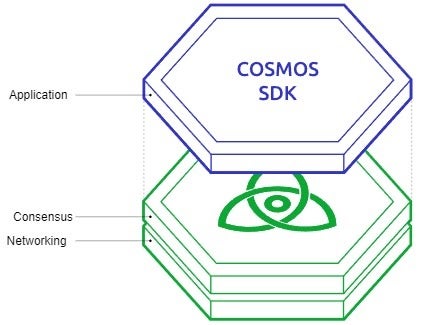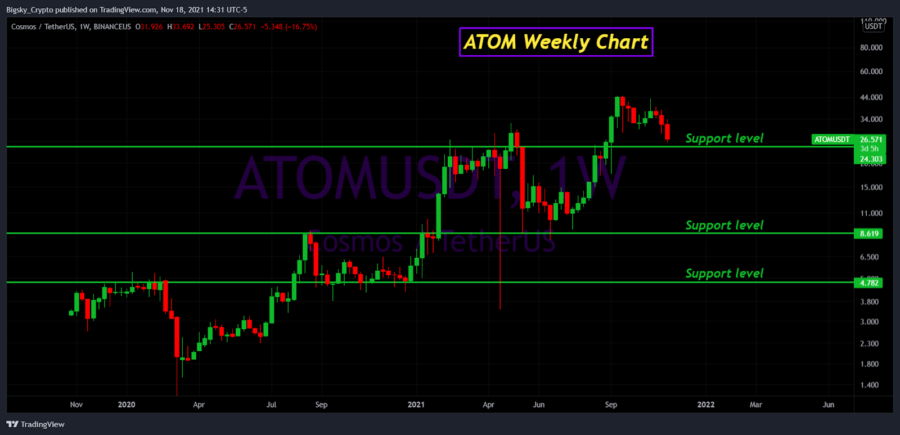
Have you decided Cosmos is a good investment? You can get ATOM on Coinbase today!
It is critical to answer the following questions when determining whether a crypto project is a good investment. Does it address a real-world issue? Who is the team behind the project? Are there any rivals? How do they stack up? What is the circulating supply of a coin or token in relation to the total supply?
Cosmos addresses 3 major blockchain issues: sovereignty, scalability and sustainability. Consider Cosmos to be an ecosystem of blockchains that can scale and communicate with one another. Interoperability between blockchains is a significant advancement because previously, blockchains were isolated islands with their own ecosystems, unable to interact with any other blockchain.
What is Cosmos (ATOM)?
© Image credit: Cosmos
Jae Kwon co-founded Cosmos and was working on the foundations of Cosmos as early as 2014. Tendermint BTF (Byzantine Fault Tolerance) was created in 2015 by Jae Kwon and Ethan Buchman. The ability to tolerate machines failing in various ways, including becoming malicious, is referred to as Byzantine fault tolerance. Cosmos is powered by the Proof-of-Stake consensus algorithm Tendermint BTF.
Tendermint blockchains are widely regarded as among the most secure and scalable in the crypto space. Jae Kwon and Ethan Buchman published the Cosmos whitepaper, “A network of distributed ledgers,” in 2016 and launched Cosmos through an ICO (initial coin offering) in April 2017.
Cosmos is a decentralized network of parallel blockchains powered by BFT consensus algorithms such as Tendermint’s. Cosmos’ goal is to make it easy for developers to build application-specific blockchains that break down the barriers between blockchains, allowing them to communicate and transact with one another. The Cosmos Hub is a decentralized network of independent, scalable and interoperable blockchains that Cosmos is working to build.
The Cosmos Hub is the first of thousands of interconnected blockchains that will form the Cosmos network in the future. The Cosmos Hub is the first public BFT blockchain powered by Proof-of-Stake, and the first BFT system deployed at scale in the over 40-year history of Byzantine Fault Tolerance (BFT) research.

© Image credit: Cosmos
Cosmos developers created the Cosmos SDK (software developer kit) to achieve their goals. The Cosmos SDK is an easy-to-use, modular framework that allows developers to create custom blockchains from scratch that can interoperate with each other on top of Tendermint. Cosmos has been used to build 260 apps and services to date.
Tendermint blockchains, in terms of scalability, can theoretically handle up to 10,000 transactions per second and continue to operate even if 1/3 of the validator nodes are offline or attempting to corrupt the network.
The Cosmos blockchain’s native token is ATOM, but Cosmos can support any number of tokens. ATOM tokens can be staked to help secure the network, and owning ATOM tokens grants you voting rights that allow you to influence the future of the Cosmos Hub through on-chain governance proposals.
Cosmos (ATOM) Price History
Since its ICO over 4.5 years ago, the ATOM token has seen incredible price growth. From the ICO price of $0.10 per token, ATOM reached a high of $46.68 (Binance) on September 24, representing a gain of more than 46,500%. If any investors took part in the ICO and kept their tokens, they are sitting on massive profits.

According to ATOM statistics, the total supply of tokens is 282,557,769, with 224,773,165.92 in circulation. ATOM’s current price is $26.40, giving it a market capitalization of $5,936,912,085 and ranking #37 on CoinMarketCap. ATOM’s peak price had a market capitalization of $10,492,411,385, so as you can see, ATOM is down approximately 44% from its peak.
Cosmos (ATOM) Competition
Cosmos’s main competitors are Polkadot (DOT) and Avalanche (AVAX). All 3 projects aim to solve the scalability and interoperability issues that plague most blockchains, but they go about it in different ways.
Polkadot employs parachains, or parallel chains, with the main chain in the center known as the relay chain. The relay chain validates transactions and distributes new transactions to the surrounding chains. Polkadot can achieve process speeds of over 1000 transactions per second by separating the validating process from the new transactions.
The core of Avalanche is a subnetwork (subnet) known as the primary network. There are three blockchains in the primary network: an exchange chain (X-chain), a platform chain (P-chain), and a contract chain (C-chain). The exchange chain is used to create and trade crypto assets. The platform chain enables the creation of new blockchains and subnetworks.
It also keeps track of active subnets and manages transaction validators. Eventually, the Avalanche network will be made up of thousands of subnets that will form an interoperable network with many blockchains. Avalanche has a very high throughput of 4,500 transactions per second (TPS) per subnet and very low latency, with 90% of all transactions occurring in less than 1 second.
Cosmos, on the other hand, employs a multi-layered design. It all starts with a central hub called the Cosmos hub, which serves as an intermediary between all of the other independent blockchains known as zones.
The zone blockchains are linked to the Cosmos hub via the Inter-Blockchain Communication protocol (IBC), which allows information to flow freely between each connected zone. Any zone that is linked to the Cosmos hub can communicate with any other zone that is linked. Cosmos claims theoretical transaction speeds of up to 10,000 transactions per second.
How to Buy Cosmos (ATOM).
If you are interested in investing in ATOM, it can be purchased on Coinbase. For those living outside of the United States, Binance, Gate.io, and Houbi Global are highly regarded cryptocurrency exchanges with extensive cryptocurrency selections.
If you buy ATOM from an exchange, you’ll need a crypto wallet to keep your private keys safe. You could simply leave it on the exchange, but for security reasons, especially if you purchase a large amount of cryptocurrency, it is generally better to remove it.
There are numerous types of cryptocurrency wallets, but the most secure is a hardware wallet. The following section will explain what a hardware wallet is and which is best for storing ATOM.
Coinbase is one of the Internet’s largest cryptocurrency trading platforms. From Bitcoin to Litecoin or Basic Attention Token to Chainlink, Coinbase makes it exceptionally simple to buy and sell major cryptocurrency pairs.
You can even earn cryptocurrency rewards through Coinbase’s unique Coinbase Earn feature. More advanced traders will love the Coinbase Pro platform, which offers more order types and enhanced functionality.
Though Coinbase doesn’t offer the most affordable pricing or the lowest fees, its simple platform is easy enough for complete beginners to master in as little as a single trade.
Best For
- New cryptocurrency traders
- Cryptocurrency traders interested in major pairs
- Cryptocurrency traders interested in a simple platform
- Simple platform is easy to operate
- Comprehensive mobile app mirrors desktop functionality
- Coinbase Earn feature rewards you with crypto for learning about available coins
- Higher fees than competitors
Best Hardware Wallet For Cosmos (ATOM)
So you’ve decided to invest in ATOM, but you want to get a cryptocurrency wallet first. There are several types of wallets available, but a hardware wallet is the most secure option.
Because it can be disconnected from the internet, a hardware wallet is a cold storage wallet. Because of the wallet’s isolation from the internet, hacking it is extremely difficult, if not impossible.
Best Hardware Wallet: Ledger Nano S or Nano X
The best hardware wallet for storing your ATOM private keys is the Ledger. For those who are unaware, when you transfer ATOM or any other cryptocurrency, you are not transferring coins or tokens but rather the private keys that demonstrate crypto ownership.
The Nano S and Nano X are the two models available from Ledger. The Nano S is less expensive, but it cannot store as many apps as the Nano X. In addition, the Nano X is Bluetooth-enabled and works with the Ledger Live mobile app. You have complete control over your digital assets when you combine either Ledger wallet with the Ledger Live desktop or mobile app. You can create and manage accounts in addition to setting up your wallet with Ledger live.
Both wallets use an industry-leading specialized Secure Element chip for security. The secure element chip, which is used in credit cards and passports, provides the highest level of security for a chip. Regardless of the Ledger model you select, you are providing the highest level of protection for your crypto assets.
Bonus Section:
The price of Bitcoin will most likely have the most significant impact on the price of ATOM in the short to medium term. If the bull market continues, it is safe to assume that the price of ATOM will rise with it. However, if Bitcoin falls into a prolonged bear market, the price of ATOM will fall as well.
Cryptocurrency Market Outlook
Will this bull market continue or is it about to end? The previous 2 bull markets peaked on November 30, 2013 and December 17, 2017. Bitcoin, and many of the altcoins, have been looking strong lately, but just when this bull market will end is still unknown.
Hopefully, there will be a few more months left before it ends. Check out this table for the latest prices.
Is Cosmos (ATOM) a Good Investment?
Now it’s time to ask the big question: Is it wise to invest in Cosmos? When compared to the other 2 competitors, ATOM is significantly less expensive.
ATOM has around a quarter of the circulating supply of Polkadot (DOT), and its price is about 30% lower. ATOM is around 77% cheaper than Avalanche (AVAX) and has approximately the same circulating supply. If Cosmos (ATOM) can continue to lure projects to its network, there should be plenty of room for price appreciation.
Benzinga crafted a specific methodology to rank cryptocurrency exchanges and tools. We prioritized platforms based on offerings, pricing and promotions, customer service, mobile app, user experience and benefits, and security. To see a comprehensive breakdown of our methodology, please visit see our Cryptocurrency Methodology page.
This news is republished from another source. You can check the original article here


Be the first to comment